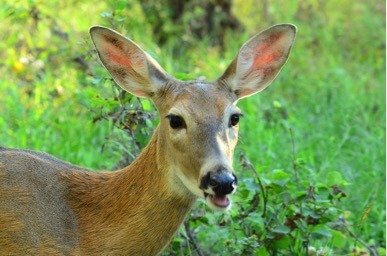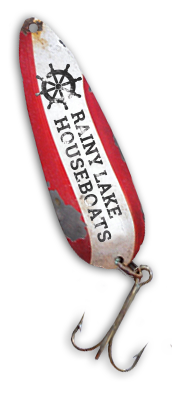Northern Minnesota’s boreal forest is packed to the brim with wildlife. Scattered between glistening lakes and streams, this lush environment is an ideal home for mammals. In fact, over 42 species of mammals can be found throughout Voyageurs National Park. Whether you stay on the water and observe from a houseboat or venture onto a hiking trail to get a closer look, you’re bound to encounter plenty of these magnificent animals. Wondering what to look for? Keep your eyes peeled for:
Black Bears
There are about 150 black bears throughout Voyageurs National Park. Spotting these towering creatures in the wild can be a memorable and possibly frightening experience. Bear attacks are extremely rare and are typically a result of improper food and garbage storage. When you’re exploring the land, store food in one of the many storage lockers located throughout the park. If you encounter a bear in the woods, change directions and leave an escape route for the bear. When they’re curious, black bears will stand on their hind legs for a better view. You may see a head peek out of the bushes from your spot on the water. You’ll feel like you’ve truly escaped civilization when you encounter a black bear!
Moose
 Moose are the largest animals in the northern hemisphere, and they tend to leave an impression on park visitors. While much of Minnesota’s moose population is declining, the Voyageurs’ population has remained steady. The Kabetogama Peninsula, just south of Rainy Lake, is home to nearly 50 moose. The abundance of wildlife in the area may have something to do with this animal’s prosperity. Wolves have a wider selection of prey and are less likely to attack moose when there are other food options. Northern Minnesota is about as far south as you’ll find moose in North America, so it’s a privilege to see one. From a houseboat, look for these herbivores on the shoreline picking branches from trees. Look a little closer and you could see a moose head pop out of the water! Water lilies are one of their favorite snacks.
Moose are the largest animals in the northern hemisphere, and they tend to leave an impression on park visitors. While much of Minnesota’s moose population is declining, the Voyageurs’ population has remained steady. The Kabetogama Peninsula, just south of Rainy Lake, is home to nearly 50 moose. The abundance of wildlife in the area may have something to do with this animal’s prosperity. Wolves have a wider selection of prey and are less likely to attack moose when there are other food options. Northern Minnesota is about as far south as you’ll find moose in North America, so it’s a privilege to see one. From a houseboat, look for these herbivores on the shoreline picking branches from trees. Look a little closer and you could see a moose head pop out of the water! Water lilies are one of their favorite snacks.
Beavers

These animals alter the landscape like no other mammal. Beavers frequently cut down trees to build dams throughout the park. The process creates new ponds, wet meadows and marshy vegetation. You’re most likely to see beavers in and around the water. These flat-tailed creatures rarely venture too far onto land, where they’re more vulnerable to predators. You may notice playful beaver behavior around the park. Beavers are known as the “practical jokers” of the animal world. Colonies typically consist of six or more beavers and are found all around Rainy Lake.
Whitetail Deer

True to its name, a whitetail deer has a white underside to its tail and body. They are very recognizable, but good luck encountering one for more than a few seconds! Deer are extremely cautious animals with strong sight, smell and hearing senses. Male deer, known as bucks, are larger and more solitary than their female counterparts. You can easily identify a male by its large set of antlers. Deer thrive at the conjunction of different types of habitats. Voyageurs’ aquatic and terrestrial landscape is perfect for whitetail deer to roam. These mammals are never stationary during the warmer months, always looking for the next patch of grass or set of leaves to enjoy. Stumbling upon a whitetail deer in the wild is something every Minnesotan should experience once!
These are just a few of the many species of mammals found in Voyageurs National Park. Spend enough time on the water and in the forest and you’re bound to spot more animals than you can count. Humans and mammals exist in harmony around Rainy Lake.
To experience this yourself, reserve a houseboat for your next vacation up north. Get an unbeatable vantage point of Mother Nature that you’ll remember forever.

